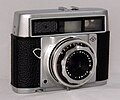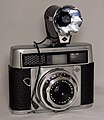Agfa Selecta
The Selecta is an auto-iris camera introduced in 1962 that was derived from the Agfa Optima . It was replaced by Agfa Selectronic in 1970 . In addition, there was a single-lens reflex camera with interchangeable lenses called Selectaflex , but there was no successor model.
Viewfinder cameras
prehistory
Agfa had already offered a camera with automatic timing with the Automatic 66 in 1956 , but for the medium format, as the necessary components could not yet be accommodated in the housing of a 35mm camera (see Agfa ). 1959 followed with the Optima, the first fully automatic 35mm camera, it worked with an automatic program, so the photographer could not influence the combination of aperture and time. So it made sense to derive a variant for committed photographers. However, the Optima sold so well that initially no production capacity was available.
Selecta
In 1962, Agfa offered a camera with an automatic shutter in the original die-cast aluminum housing of the Optima. Agfa spoke of a selective automatic and then named the model Selecta . On the housing, there was no need for a dial for flash mode below the release lever and the rewind button was no longer retractable , as with the Optima, and had a crank. The partially synchronized Prontor-Matic lock had the times 1/30 - 1/500 and, as a special feature, could be set continuously. Manual setting of the exposure time was possible, there was also a self-timer and the option of connecting a cable release.
The Selecta had a Color-Apotar f / 2.8, 45 mm and cost 278 DM, the price for a three-lens lens was quite high due to the expensive aluminum housing and, according to the sales figures, were quite low.
Selecta m
The company Iloca-Witt had to file for bankruptcy in 1962 due to the non-delivery of 3200 shutters ordered for the new cameras (the suppliers were now firmly in the hands of the competition). This is how Agfa acquired one of the most modern cameras currently available with motorized film transport and an automatic shutter / shutter combination - the Iloca auto electric. After five years of legal battle after the "attack", Iloca was right, but nothing could be saved. Agfa accommodated the interior of the ILOCA auto electric largely unchanged in the housing of the Optima and presented the result as Selecta m at the same time as the usual Selecta . The motor drive worked with two 1.5 V batteries. For 598 DM there was also a four-lens lens, the Color-Solinar R, where R stood for the supplier Rodenstock , and a viewfinder with parallax compensation. The high price, however, resulted in a very low distribution.
Originally it was even planned to offer an Optima electric , i.e. the combination of motor drive plus automatic program, and had already created several prototypes and press photos for it.
SLR camera
Selectaflex
In 1963, Agfa even introduced the automatic shutter in a reflex camera with interchangeable lenses and a prism viewfinder. The Selectaflex carried an unmistakable selenium cell for exposure measurement, it was available as Selectaflex I with the Color-Solinar f 2.8 / 50 mm and as Selectaflex II with the Color-Solagon f 2.0 / 55 mm. The following interchangeable lenses were available: The wide-angle Color-Ambion f 3.4 / 35 mm; the color telinear f 3.4 / 90 mm; the Color-Telinear f 4.0 / 135 mm and the rarely bought Color-Telinear f 4.5 / 180 mm.
Although other manufacturers had long since switched to aluminum, all lenses still had brass mounts, which made the 180 mm particularly difficult. This also showed that Agfa did not want to build its own camera system, but only thought of a camera with extended capabilities. Due to the lack of success, the single-lens reflex technology was finally abandoned entirely. It was not until 1980 that such a camera with the Agfa logo came back with the Selectronic .
The Ambiflex lenses can also be attached to the Selectaflex . Conversely, this only applied to the Ambion and Solagon , if the other lenses were attached to the Selctaflex , they could only be removed again with a mechanical intervention. The Ambiflex lenses could be recognized by a funnel-shaped notch on the marking for the distance scale .
gallery
literature
- Günther Kadlubek, Rudolf Hillebrand: AGFA - History of a German global company from 1867 to 1997 . 2nd edition, Verlag Rudolf Hillebrand, Neuss 1998, ISBN 3-89506-169-7 .




